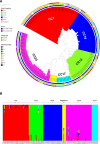Genomic characterisation of perinatal Western Australian Streptococcus agalactiae isolates
- PMID: 31577825
- PMCID: PMC6774530
- DOI: 10.1371/journal.pone.0223256
Genomic characterisation of perinatal Western Australian Streptococcus agalactiae isolates
Abstract
As a leading cause of neonatal sepsis, Streptococcus agalactiae, commonly known as Group B Streptococcus, is a major neonatal pathogen. Current global screening practices employ risk- or culture-based protocols for detection of these organisms. In Western Australia (WA), universal culture-based screening is provided, with subsequent intrapartum antibiotic prophylaxis for all S. agalactiae-positive women during labour. Widespread antibiotic exposure is not ideal and this is one of the factors driving development of vaccines against S. agalactiae. Vaccine candidates have focused on the capsule, surface proteins and pilus types, however, capsule serotypes are known to vary geographically. The aim of this study was to use genome sequencing to gain an understanding of the circulating genotypes in WA, and to assess variations in the associated gene pools. We sequenced 141 antenatal carriage (vaginal/rectal) isolates and 10 neonatal invasive disease isolates from WA. Based on the global PubMLST database, the 151 strains were characterised into 30 sequence types, with clustering of these mainly into clonal complexes 1, 12, 17, 19 and 23. Of the genes encoding eleven surface proteins that were analysed, the most prevalent were fbp, lmb and scpB which were present in ≥ 98% of isolates. A cluster of non-haemolytic isolates, one of which was a neonatal invasive disease isolate, appeared to lack the entire cyl locus. Admixture analysis of population structure revealed evidence of genetic transfer among the WA isolates across structural groups. When compared against the PubMLST S. agalactiae data, WA isolates showed high levels of strain diversity with minimal apparent clustering. This is the first whole genome sequence study of WA S. agalactiae isolates and also represents the first addition of Australian isolate data to PubMLST. This report provides insight into the distribution and diversity of vaccine targets of S. agalactiae within Western Australia, indicating that the most appropriate capsular vaccine for this population would be the proposed pentavalent (Cps Ia, Ib, II, III and V) preparation, whilst vaccines targeting surface proteins should ideally utilise Fbp, Lmb and/or ScpB.
Conflict of interest statement
The authors have declared that no competing interests exist.
Figures


Similar articles
-
Molecular serotyping, virulence gene profiling and pathogenicity of Streptococcus agalactiae isolated from tilapia farms in Thailand by multiplex PCR.J Appl Microbiol. 2017 Jun;122(6):1497-1507. doi: 10.1111/jam.13447. Epub 2017 May 9. J Appl Microbiol. 2017. PMID: 28295891
-
Microevolution of Streptococcus agalactiae ST-261 from Australia Indicates Dissemination via Imported Tilapia and Ongoing Adaptation to Marine Hosts or Environment.Appl Environ Microbiol. 2018 Aug 1;84(16):e00859-18. doi: 10.1128/AEM.00859-18. Print 2018 Aug 15. Appl Environ Microbiol. 2018. PMID: 29915111 Free PMC article.
-
Prevalence, serotypes and virulence genes of Streptococcus agalactiae isolated from pregnant women with 35-37 weeks of gestation.BMC Infect Dis. 2021 Jan 14;21(1):73. doi: 10.1186/s12879-020-05603-5. BMC Infect Dis. 2021. PMID: 33446117 Free PMC article.
-
The prevention of early-onset neonatal group B streptococcal disease.J Obstet Gynaecol Can. 2013 Oct;35(10):939-948. doi: 10.1016/S1701-2163(15)30818-5. J Obstet Gynaecol Can. 2013. PMID: 24165063 Review.
-
Molecular epidemiology of Streptococcus agalactiae in non-pregnant populations: a systematic review.Microb Genom. 2023 Nov;9(11):001140. doi: 10.1099/mgen.0.001140. Microb Genom. 2023. PMID: 38019122 Free PMC article.
Cited by
-
Macrolide and lincosamide resistance of Streptococcus agalactiae in pregnant women in Poland.Sci Rep. 2024 Feb 16;14(1):3877. doi: 10.1038/s41598-024-54521-y. Sci Rep. 2024. PMID: 38366099 Free PMC article.
-
Molecular typing and prevalence of antibiotic resistance and virulence genes in Streptococcus agalactiae isolated from Chinese dairy cows with clinical mastitis.PLoS One. 2022 May 6;17(5):e0268262. doi: 10.1371/journal.pone.0268262. eCollection 2022. PLoS One. 2022. PMID: 35522690 Free PMC article.
-
First Report of Streptococcus agalactiae Meningitis in a Non-Pregnant Adult in Italy.Microorganisms. 2025 Apr 24;13(5):978. doi: 10.3390/microorganisms13050978. Microorganisms. 2025. PMID: 40431151 Free PMC article.
-
Molecular Epidemiology of Group B Streptococcus Colonization in Egyptian Women.Microorganisms. 2022 Dec 22;11(1):38. doi: 10.3390/microorganisms11010038. Microorganisms. 2022. PMID: 36677330 Free PMC article.
-
Host range, morphological and genomic characterisation of bacteriophages with activity against clinical Streptococcus agalactiae isolates.PLoS One. 2020 Jun 23;15(6):e0235002. doi: 10.1371/journal.pone.0235002. eCollection 2020. PLoS One. 2020. PMID: 32574197 Free PMC article.
References
-
- Verani JR, McGee L, Schrag SJ (2010) Prevention of perinanatal group B streptococcal disease: revised guidelines from CDC, 2010. Recommendations and Reports 59: 1–32. - PubMed
-
- Russell NJ, Seale AC, O’Driscoll M, O’Sullivan C, Bianchi-Jassir F, Gonzalez-Guarin J, et al. (2017) Maternal colonization with group B Streptococcus and serotype distribution worldwide: Systematic review and meta-analyses. Clinical Infectious Diseases 65: S100–S111. 10.1093/cid/cix658 - DOI - PMC - PubMed
-
- Furfaro LL, Nathan EA, Chang BJ, Payne MS (2019) Group B streptococcus prevalence, serotype distribution and colonization dynamics in Western Australian pregnant women. Journal of Medical Microbiology. - PubMed
Publication types
MeSH terms
LinkOut - more resources
Full Text Sources
Research Materials
Miscellaneous

